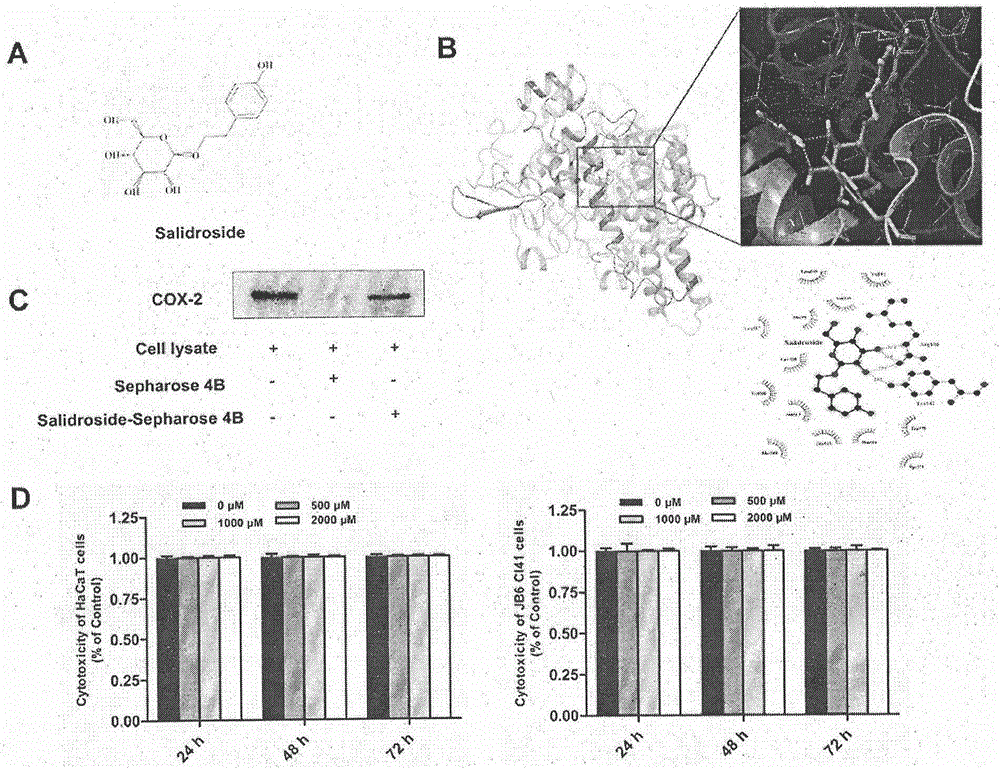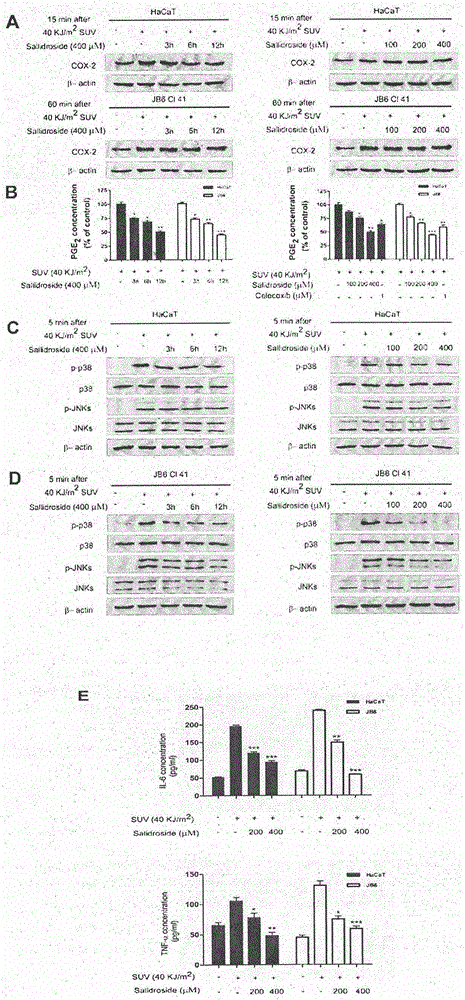Application of salidroside in prevention and/or treatment of skin inflammation caused by abnormal increase of COX-2 activity through inhibition of cyclooxygenase-2(COX-2)
A technology of COX-2 and salidroside, applied in skin diseases, organic active ingredients, drug combinations, etc.
- Summary
- Abstract
- Description
- Claims
- Application Information
AI Technical Summary
Problems solved by technology
Method used
Image
Examples
Embodiment 1
[0059] Example 1 Salidroside can directly bind to COX-2.
[0060] Traditional Chinese medicine has special pharmacological effects. Finding a natural and non-toxic drug can provide us with new methods and new ideas for clinical treatment of diseases. Therefore, we applied structure-based virtual screening in traditional Chinese medicine to identify novel COX-2 inhibitors. We identified salidroside, which is extracted from Rhodiola rosea, as a COX-2 inhibitor. Molecular modeling showed that the sugar groups of Rhodiola can form hydrogen bonds with the protein amino acid residues ARG106 and TYR341 of COX-2. Therefore, it can be said that salidroside can bind to COX-2. To test this prediction, we performed an in vitro protein binding assay to investigate whether salidroside could bind COX-2 in HaCaT cell lysates. The results showed that COX-2 could bind to salidroside-Sepharose 4B beads, but not to Sepharose 4B beads. Experimental data confirmed that salidroside can directly ...
Embodiment 2
[0067] Example 2 Salidroside inhibits the activation of COX-2 and its downstream p38 or JNKs activation, and reduces the secretion of inflammatory factors in HaCaT and JB6CL41 cells.
[0068] Because Rhodiola can directly bind to COX-2, we next explored whether it can inhibit the activity of COX-2. First, we use Rhodiola rosea (400μM), 40KJ / m 2 , were irradiated for 15 minutes (HaCaT cells) and 60 minutes (JB6CL41 cells), respectively, to observe the inhibitory effect of salidroside on COX-2 levels in the two cells under different pretreatment times, and observed that after 12 hours of pretreatment, red Sedroside has an inhibitory effect on it. Secondly, we use Rhodiola rosea (400μM), 40KJ / m 2 , were irradiated for 15 minutes (HaCaT cells) and 60 minutes (JB6CL41 cells), respectively, and observed the effect of different salidroside pretreatment doses on them. It was observed that 400 μM pretreatment salidroside had an inhibitory effect on COX-2. PGE2 represents the activit...
Embodiment 3
[0073] Example 3 Increased expression of COX-2 in actinic dermatosis caused by UV.
[0074] 1) The phosphorylation levels of COX-2, P38, or JNKs are all elevated in human actinic dermatosis (chronic actinic dermatitis).
[0075] Ultraviolet (UVB) irradiation can cause oxidative damage and inflammation in the body, and ultimately increase the risk of skin cancer, and COX-2, p38, and JNKs signaling pathways are involved in this process. Actinic dermatosis is closely related to UV radiation. Therefore, we detected the phosphorylation levels of COX-2, p38 and JNKs signaling pathways in skin lesions of 5 patients with actinic dermatosis and skin samples of 2 normal individuals. . Histopathological H&E staining of actinic dermatosis compared with normal skin lesions showed epidermal hyperkeratosis, epidermal hyperplasia, spinous process elongation, intercellular edema, superficial dermal vascular dilation, and lymphocyte infiltration in the superficial dermis and around blood vesse...
PUM
 Login to View More
Login to View More Abstract
Description
Claims
Application Information
 Login to View More
Login to View More - R&D
- Intellectual Property
- Life Sciences
- Materials
- Tech Scout
- Unparalleled Data Quality
- Higher Quality Content
- 60% Fewer Hallucinations
Browse by: Latest US Patents, China's latest patents, Technical Efficacy Thesaurus, Application Domain, Technology Topic, Popular Technical Reports.
© 2025 PatSnap. All rights reserved.Legal|Privacy policy|Modern Slavery Act Transparency Statement|Sitemap|About US| Contact US: help@patsnap.com



